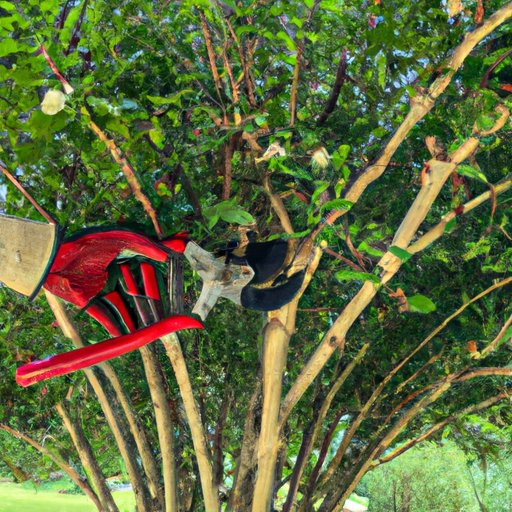
I. Introduction
Crepe myrtle plants are known for their vibrant floral displays and hardiness in various climates. These trees or shrubs add incredible appeal to any landscape. However, pruning crepe myrtle is essential for their longevity, growth, and aesthetic appeal.
II. The Ultimate Guide to Pruning Crepe Myrtle: A Step-by-Step Approach
Correct pruning of crepe myrtle plants is essential to prevent the likelihood of damage or diseases. Here are the standard steps to follow when pruning a crepe myrtle plant:
- First, remove any unwanted shoots or stems that come out of the ground. This is important because these shoots take away significant energy from the rest of the plant, leading to stunted growth.
- Next, remove any small branches or shoots at the bottom of the plant. These are known as suckers and take away resources from the tree’s critical parts and prevent proper blooming.
- Identify fast-growing branches and cut them back to their nodes’ next set to ensure blooming and enhanced foliage.
- Trim the center branches to promote better sunlight and better airflow within the tree.
- Remove all crossing and rubbing branches. This technique encourages healthy wood growth while also enhancing the overall appearance of the tree.
Before pruning your crepe myrtle, it’s essential to have the right tools on hand. A sharp pair of pruning shears is ideal for small branches, while a long-handled pruning saw will be handy for larger branches. Loppers will be useful for branches larger than one inch in diameter. When pruning your tree, it’s essential to be mindful to avoid pruning away more than 1/3 of the tree’s total volume. Proper pruning and pruning techniques can prevent unwanted growth and ensure that your tree flourishes for years to come.
III. 5 Easy Tips for Pruning Your Crepe Myrtle like a Pro
Pruning your crepe myrtle can be easy, efficient, and lead to gorgeous blooms. Here are 5 easy tips to help:
- Prune when the tree is dormant: pruning during the dormant season, typically mid to late winter, stimulates healthy growth in the spring.
- Use a step stool or ladder: this will ensure that you can reach all the key areas that may need pruning.
- Don’t leave stubs: when pruning, it’s best to make a clean cut. Leaving a stub can encourage the growth of unwanted shoots and branches.
- Prune at an angle: when making a cut, aim for an angle between 45-60 degrees. This will help the tree heal more quickly.
- Take it slowly: take your time when pruning your crepe myrtle to ensure that you avoid making any significant mistakes that could harm the tree.
IV. Why Pruning Crepe Myrtle is an Important Part of Tree Maintenance
Pruning crepe myrtle is critical for overall tree maintenance. Here’s why:
- Ensuring proper growth and blooming: Pruning will prevent the growth of competing branches and allow the tree to invest resources into larger, better branches that ensure adequate nutrients and sunlight for blooming when the time is right.
- Maintaining a healthy tree structure: pruning can improve the appearance and overall health of the tree. Preventative pruning can remove any weak branches that can fail during a storm or excess foliage that could potentially harm the tree.
- Pest and Disease Prevention: Pruning can eliminate any dead wood or foliage that can harbor pests or diseases that can eventually kill the tree.
V. Pruning Crepe Myrtle: Dos and Don’ts
Here are some helpful dos-and-don’ts when it comes to pruning your crepe myrtle:
- Do prune annually: This helps to prevent suckers, ensuring that the tree’s growth is concentrated on top.
- Don’t top your crepe myrtle. Topping involves cutting off the tree’s top, which makes it prone to diseases and pests.
- Do prune the right branches. Focus on dead or rubbing branches, leaving healthy ones untouched.
- Don’t prune the tree’s top, which can interfere with its natural shape.
- Do prune at the right time. Avoid pruning during hot weather or when the tree is in full bloom.
- Don’t treat large branches with pruning paint or wound dressing. These materials can interfere with the tree’s natural healing process.
When pruning crepe myrtle, it’s also essential to consider the age of the tree. Younger trees need more special attention, as they need to form a shape and direction that will promote healthy growth. Older trees need less focused and more routine care.
VI. When to Prune Your Crepe Myrtles: The Ultimate Guide
The best time to prune crepe myrtle trees is in late winter after dormancy and before the beginning of spring growth. Late winter offers an ideal time for trimming because trees that are dormant will be less stressful than when they are working to establish new growth.
However, many experts suggest that the best time to prune your crepe myrtle depends on the region in which you live. Gardeners in colder regions should prune their trees in late winter or early spring at the beginning of the growing season. Gardeners in warmer regions have the liberty to prune their trees after the blooming cycles have inspired new shoots.
VII. Conclusion
Pruning crepe myrtle is an essential tree maintenance technique that is easy to do. Keeping your crepe myrtle healthy and vibrant is only a matter of following proper pruning techniques, removing waste and old foliage, and paying attention to the timing of pruning. So grab your tools and your knowledge and help your crepe myrtle reach its full potential.




